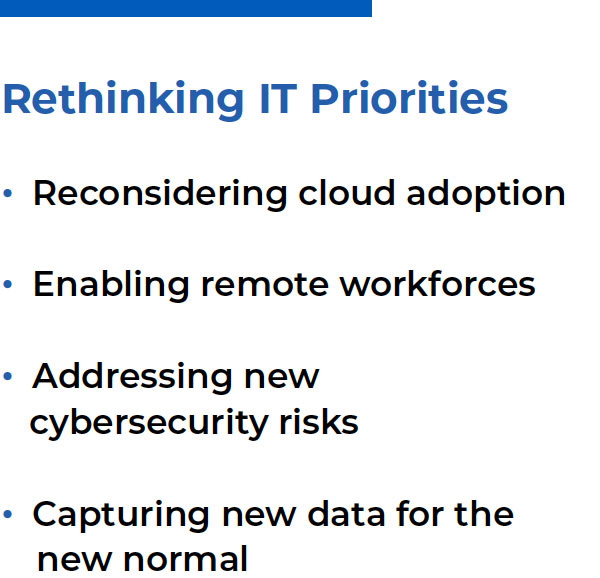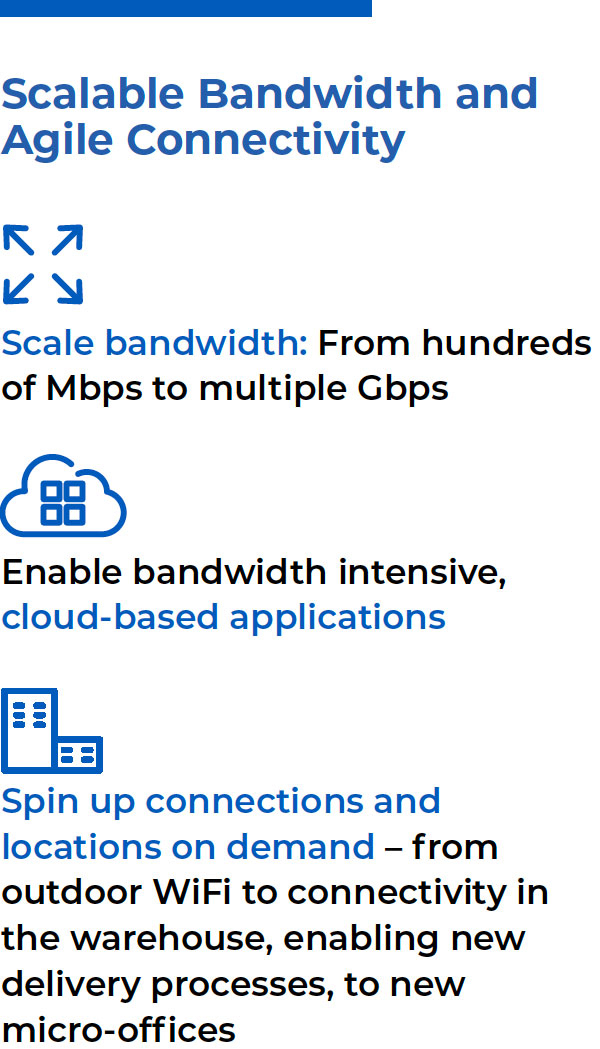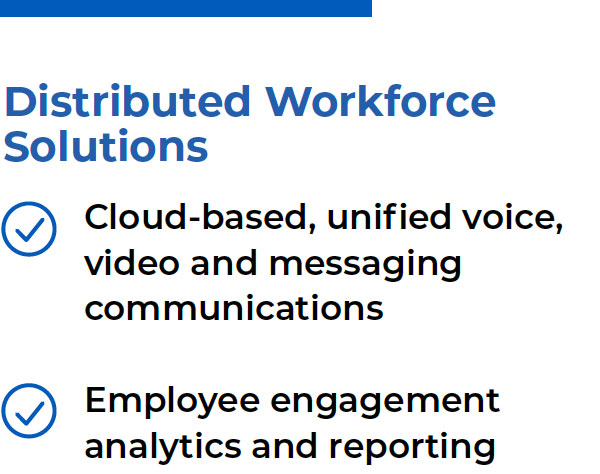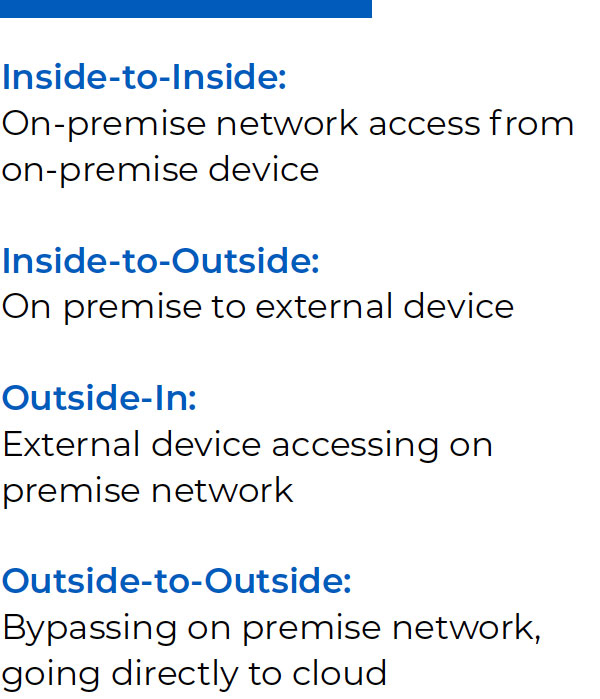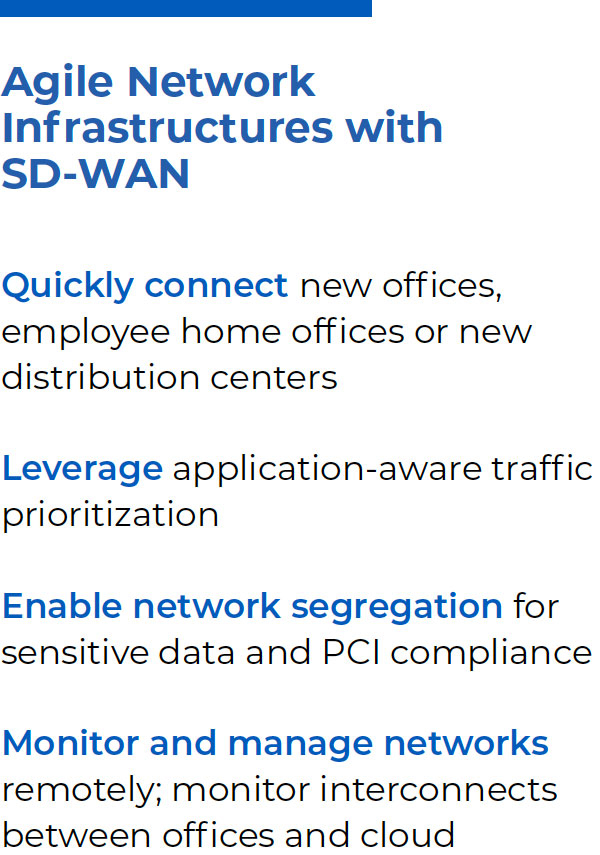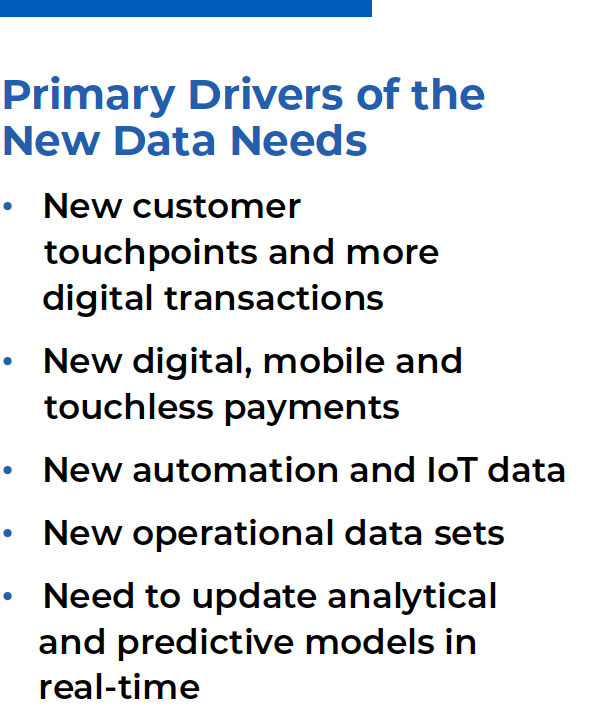Enabling New Ways of Doing Business with Agile IT Architectures

It is widely acknowledged that the pandemic put a strain on most companies’ business continuity preparedness and accelerated digital transformation efforts that may or may not have already been in motion. Companies in all industries and of all sizes are now forced to rethink how to conduct business, how to enable employees, how to deliver products and services, and how to engage with customers in new ways. To support the required changes, companies need to start with rethinking their enterprise IT and network architectures.
There are two major drivers pushing organizations to re-examine enterprise IT architectures. First, the crisis forced the move to remote work. With the majority of users outside of the traditional enterprise perimeter, IT architectures are getting tested in many new and different ways. Managing at-home employees at scale affected core IT areas such as user access, device enablement, application availability, network topology, cybersecurity, and IT operation monitoring and management. These challenges are here to stay as the return to work will most likely ebb and flow with some companies already announcing the adoption of a more remote working model for the long term. Additionally, for the foreseeable future, there will be more remote and digital business in general. Many, if not most enterprise architectures weren’t built for this scenario. Secondly, the crisis forced businesses, especially in high-touch, consumer-facing industries like food and beverage, restaurants, retail, personal services, and healthcare to completely rethink and re-organize many of their business processes from both the employee and customer perspectives. To enable new processes and ways of doing business, companies need to re-examine their technology solutions, deploy new applications, consider where applications, data, and computing power are hosted, and determine how all of these elements are connected to each other and their user base. This big “re-shuffle” has emphasized the critical role of enterprise networks as the connective tissue in the business and the urgent need for infrastructure improvements to enable agile business.
CIOs, and the IT function in general, are now empowered to have a much more strategic and elevated role to support, enable and help reimagine their business in an effort to increase – or at least maintain – revenue. IT leaders are responding by reconsidering cloud adoption, further enabling the remote workforce with collaboration tools, dealing with the new vectors of cybersecurity risk, and capturing new data to drive insights into the new business normal. “The paradigm has completely changed,” according to Amit Verma, Vice President, Solution Engineering & Technology, Comcast Business. “Previously, data was confined to one place with access coming primarily from the inside. Now the data is still on the inside, but everyone is on the outside. Architectures need to be adjusted to allow for secure access for all employees.” To be successful in these endeavors, companies are reconfiguring their connectivity and deploying agile networks to accommodate these new needs.
Cloud Adoption, Distributed Users, and the New Network Needs
In response to the conditions brought on by the crisis, more companies are adopting cloud computing to be able to quickly address the new business requirements. “The key thing we are seeing is an acceleration of the migration to cloud applications and cloud platforms for increased agility and flexibility,” says Courtney Munroe, Group Vice President, Worldwide Telecommunications at IDC. “Even those who previously had a more conservative approach to cloud, due to data security concerns and the desire to retain data on premise, are rethinking that stance.” As employees are no longer on premise and in many industries more and more customers are transacting digitally versus in-person, the data center, the infrastructure and the applications need to follow. As a result, many companies are considering how to get technology closer to their customers and employees with the creation of new touch points, micro- branches, hoteling spaces, as well as possibly moving infrastructure out of city cores to more geographically dispersed sites.
Companies are addressing these critical questions: How quickly can they adopt cloud solutions? How will remote employees connect to the company network and business applications? How will they manage and maintain connectivity, authentication and communications?
Direct-to-Cloud Connectivity
As businesses move data-intensive applications and workflows off premises, their expectation is that those resources will perform as if they were inside the company’s network, without frustrating transmission delays or interruptions. Private Ethernet connections address these challenges and can provide access to hundreds of data centers across the country, as well as secure, direct connectivity to leading cloud service providers including AWS, Microsoft Azure and IBM Cloud.
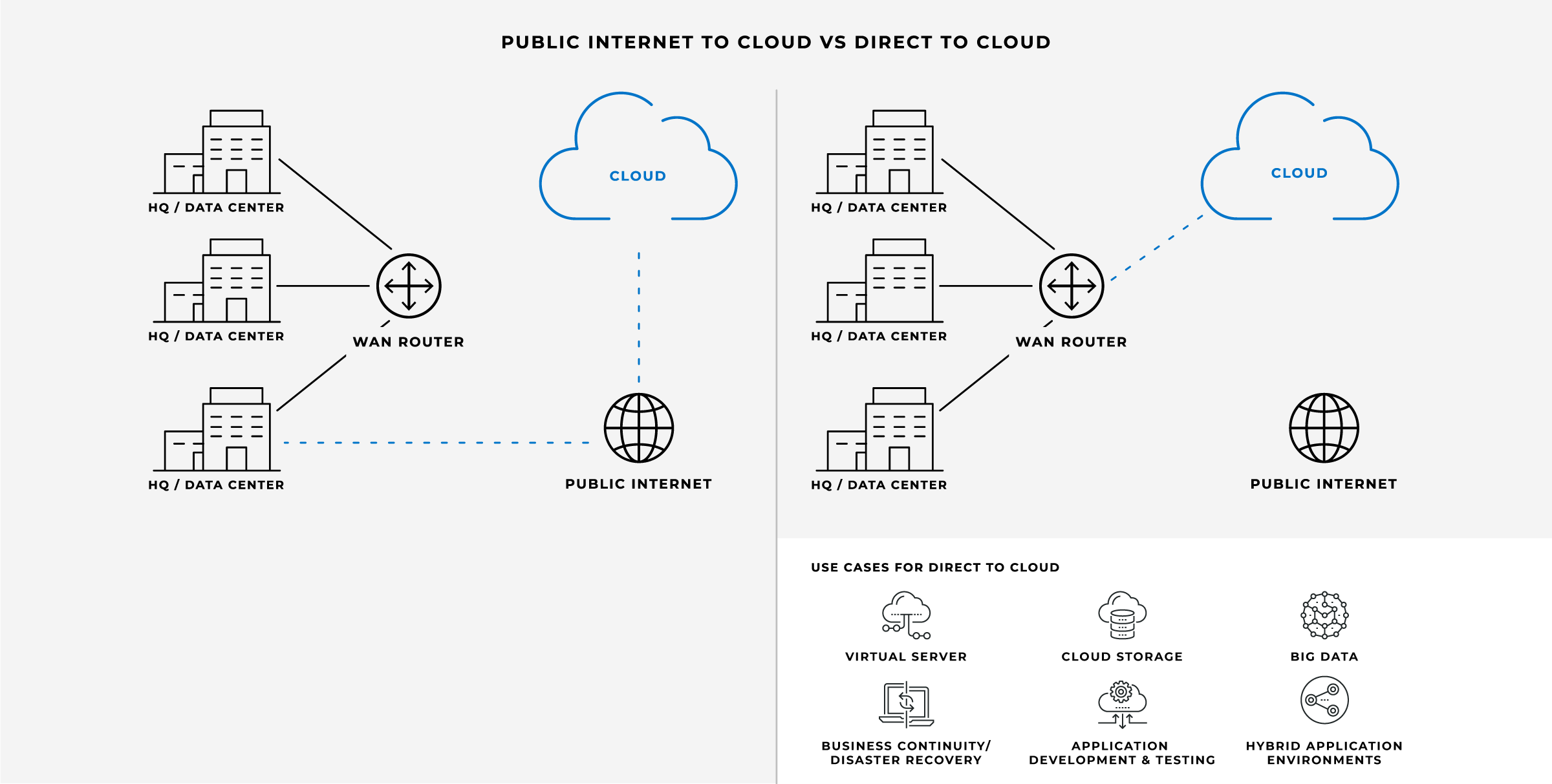

Direct-to-cloud services can provide private connections running at speeds between 10 Mbps and 100 Gbps from an enterprise-designated site(s) to data centers and/or cloud service providers. This makes it possible to set up one or more VLANs that can interface directly and securely with cloud applications. As a result, businesses can enjoy a secure, private connection and reliable, consistent performance, regardless of where vital IT resources reside. Dedicated cloud connections and HQ interconnects are ideal for mission- critical workloads, hybrid cloud applications, sensitive data transfers, and security compliance. Furthermore, they can enable big data applications and remote data management and analytics.
Enabling the Distributed Enterprise: Bandwidth and Dedicated New Connections
With the adoption of more cloud-based applications and solutions, bandwidth needs have changed. In order to support these bandwidth-intensive, high- volume applications that now reside in the cloud, organizations need a secure, reliable, high-performance Internet service. Dedicated Internet connections help organizations not only survive but thrive in today’s digital environment, providing a dedicated connection between an existing local area network and the Internet.
As new sites and micro-branches get spun up, companies will also need to improve business efficiency with dedicated point-to-point connections between sites. Multipoint-to-multipoint services allow users to transmit network traffic across all locations with maximum redundancy and minimum latency.
The need for speed and agility is paramount to productivity. As a result of moving off-premise and implementing new work processes, in many instances, companies need to rapidly scale transmission capacity, sometimes from 10 Mbps to 100 Mbps, and sometimes all the way to multiple Gbps. Dedicated Ethernet service and direct-to-cloud connections will provide the necessary solutions to maintain minimum latency. Dedicated Ethernet service can serve as augmentation or a replacement for traditional TDM Private Lines, VPNs and IP VPNs. For ease of management, such services also support Service Multiplexed User Network Interfaces (UNI), enabling a single physical connection to Customer Premise Equipment (CPE). Furthermore, EVPL (Ethernet Virtual Private Lines) services can give organizations an EVC between locations – similar to Ethernet Private Line service – and also support the added flexibility to multiplex multiple services (EVCs) on a single UNI at a customer’s hub or aggregation site.
Even though many organizations have managed to catch up on VPN connectivity needs, user access and cybersecurity remain paramount. Ethernet Virtual Private Lines not only address security concerns but can improve application performance across networks with a private, point-to-multipoint network design between multiple locations.
To ensure minimal loss in employee productivity, many companies are looking to enable enterprise-grade broadband services for the at-home distributed workforce. By providing a separate, business-grade Internet connection in the home, companies can ensure that employees no longer need to compete for bandwidth with others working, learning, or playing off the same home connection. They can connect to work applications, join video calls and utilize high-bandwidth collaboration tools without lags or performance issues. Furthermore, corporate IT teams can more effectively manage and update employee devices and applications remotely. To retain consolidated management of employee accounts, companies need to look for providers who can deliver both flexibility for the individual employee to manage their services, as well as functionality for master billing and overall account management. With flexible account management platforms, companies can assign user types and permissions for each role and access permissions supporting both productivity and overall efficiency.
Empowering the Distributed Workforce with Unified Communications and Analytics
To stay connected and productive in this new environment, employees also need next-generation, business-grade solutions for a seamless communications experience. Unified Communications enable employees and outside parties to communicate and collaborate using cloud voice, messaging, video conferencing, contact center, workforce mobility tools, and a suite of related cloud-based business applications. From transferring office calls to employee mobile numbers so calls aren’t missed, to starting work streams on one channel and continuing across communication platforms, to giving the entire workforce the tools to collaborate, companies need to ensure that the remote working experience is as efficient as the in-office one.
While providing remote connectivity solutions may be the first priority, companies need ways to measure and analyze remote employee engagement and productivity. Using advanced networking solutions, companies can collect data for ongoing workforce analytics, using new KPIs such as number and duration of calls and video conference calls, volume of emails, time spent using applications, and various other digital transactions. Such functionality can be helpful to all types of organizations, but is specifically helpful in optimizing call center productivity.
Benefits of Unified Communication Solutions

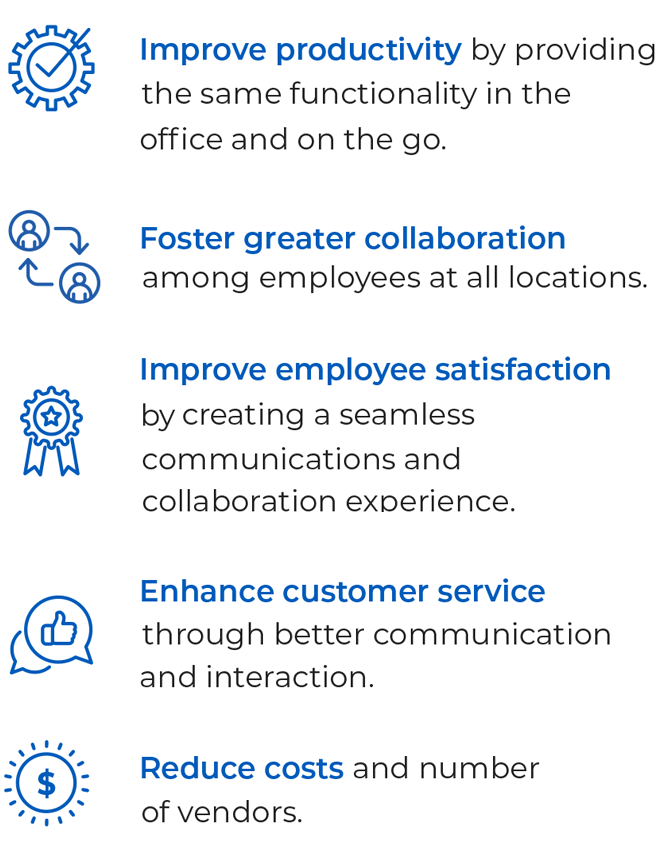
SD-WAN Solutions
As companies continue to move applications to the cloud and deploy new cloud-native apps, performance and user experience need to take center stage. In order to ensure the appropriate application prioritization, organizations need software-defined networking and SD-WAN to achieve the necessary agile connectivity and application-aware networking. The changing network traffic patterns – from the drastic increases in video calls, collaboration tools usage, and voice call volumes to automation through IoT and remote machine-to-machine (M2M) communications – require quick responses to maintain optimal performance. “The key benefit of SD-WAN is that it is easy to scale,” according to Munroe. “You can manage various protocols, whether it’s broadband, dedicated Internet access, or Ethernet or fiber, an SD WAN orchestrator allows you to efficiently manage SLAs and manage the performance of applications over that network. We believe that SD-WAN adoption will continue to grow strongly over the next 12 to 24 months.”
Companies are now connecting with their customers in new ways and agile networks are needed to support an omni-channel digital experience. In addition, the new work environment has resulted in less intra-branch communications and data is now needed closer to the edge. As the traditional network perimeter has mostly disappeared, the role of the WAN has changed. Traffic patterns have switched from “inside-to-inside” and “inside-to-outside” to “outside-in” and “outside-to-outside” connections. This shift of accessing the company networks from a remote location, rather than from on premise or via VPN, is forcing the need to change WAN configurations. Initial network configuration and ongoing management have become more complex. There is an increased need for centralized network policy management and the ability to make changes across multiple sites with a single click, as opposed to reconfiguring for each location. With SD-WAN, companies can create dynamic policies to direct traffic over the optimal path and also enable automatic failover to guarantee performance and resiliency.

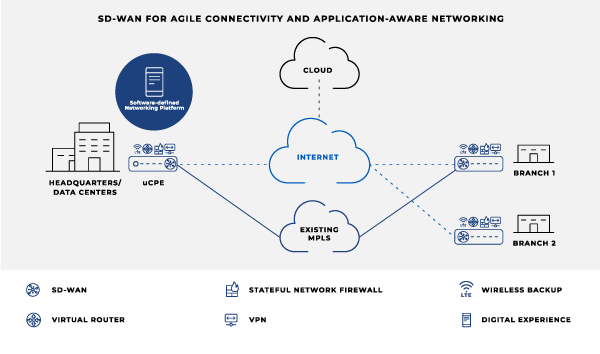
Connecting the new “micro-branches” and spinning up new locations brings up new needs around speed of deployment, redundancy and reliability. The ability to scale connectivity and bandwidth up as well as down, depending on locations and patterns, has become critical.
SD-WAN solutions also allow for several underlays and complex vendor management and help maintain business continuity with 4G LTE backups. Through features like data replication, they can ensure that voice and video communications are maintained if there is an impairment on the network. SD-WAN capabilities can be enhanced with VPNs and integrated stateful or next-generation firewalls to better manage security and compliance.
Businesses can architect their networks based on their specific needs and the criticality of their applications. As mentioned previously, branches can offload to the cloud less critical applications like Office 365 but send more critical traffic over their private network to their public or private data centers via a direct connection. In addition, companies can design their networks to mitigate failure with high-availability architectures that minimize downtown through redundancy.
In order to maintain existing private data networks and transition over time, a hybrid SD-WAN allows businesses to incrementally transition their networks to software defined with no need to rip and replace existing legacy infrastructures. A hybrid approach enables network traffic to be routed dynamically across a new broadband WAN or over the legacy path network. This approach provides the increased bandwidth to gigabit speeds, while also allowing time to migrate applications from legacy services.
Last but not least, remote network management has become a critical capability as staff may be precluded from visiting premises. With SD-WAN solutions, companies can gain valuable insights into their network performance on a single management console, orchestrate the network remotely and create templates for sites sharing routing policies – allowing changes to be pushed remotely to all locations at once. With more advanced SD-WAN solutions, companies can also enable integration of multi-vendor technologies to scale new applications quickly.
Cybersecurity Considerations
As discussed above, the traditional enterprise boundaries have disappeared. Whereas previously companies were looking to protect systems and data, now more than ever the focus is on the users and their connectivity to those systems. Companies need to consider the deployment of software-defined wide area networks (SD-WAN), next-generation firewall (NGFW), cloud access security broker (CASB) and distributed denial-of-service (DDoS) mitigation and other cybersecurity solutions to address the new environment.
With SD-WAN solutions, companies can gain visibility with anytime, anywhere monitoring of the virtualized network functions and centralize control of their distributed network. Coupled with Virtual Private Networks (VPN), companies can ensure not only centralized monitoring but secure transport of data and access to applications. Additionally, Cloud Access Security Broker (CASB) solutions, i.e. the software that sits between cloud users and cloud applications, and monitors activity and enforces security policies, are in high demand.
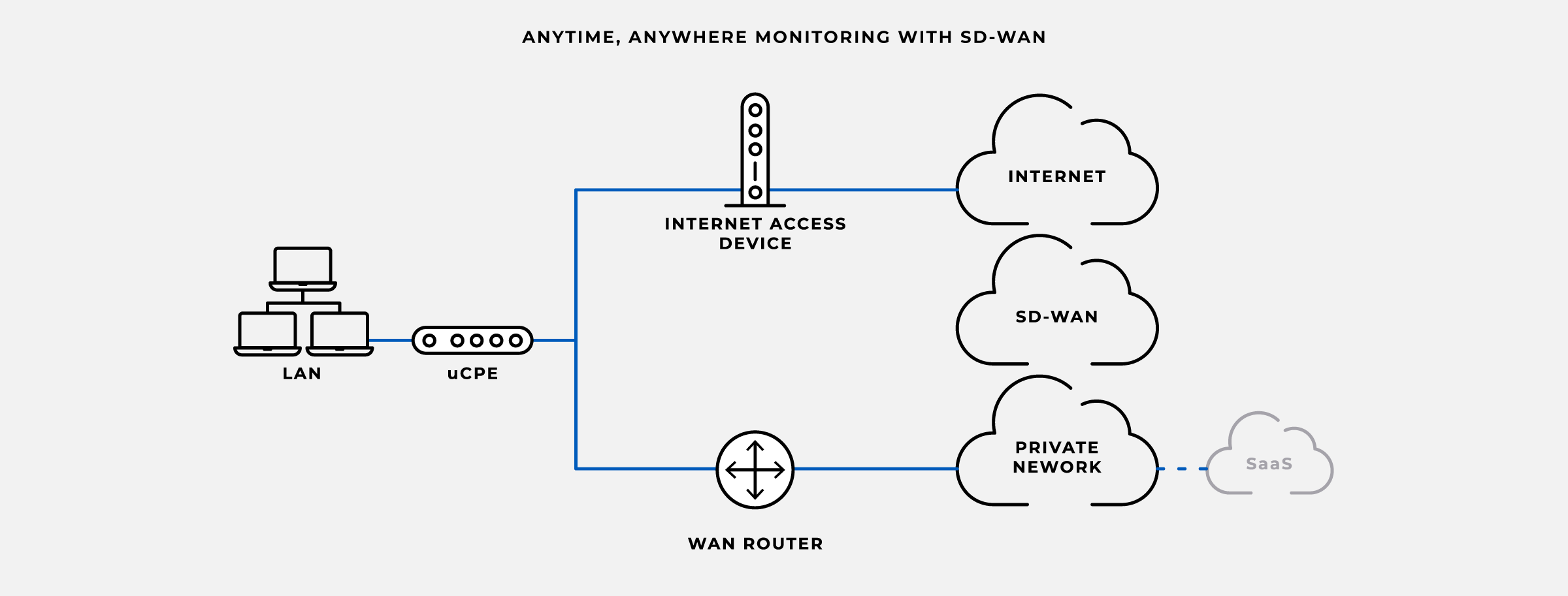
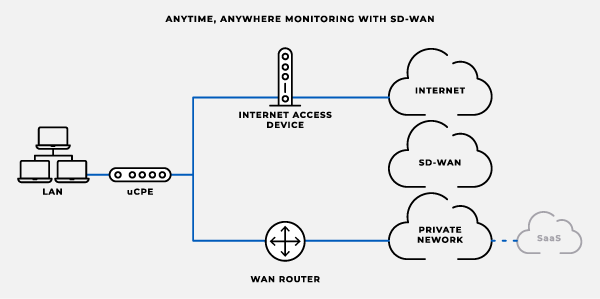
Many organizations are also turning to Unified Threat Management (UTM) solutions to address the expanded network perimeter, the new points of entry, as well as internal threats, with an array of network security measures, while eliminating the need for multiple systems. UTM solutions provide enhanced monitoring with greater visibility and rationalized computing resources.
With the increased demands of digital business and the exploding volume of online transactions, companies should consider reducing their vulnerability to distributed denial of service (DDoS) or application-layer attacks. DDoS solutions provide real-time detection and mitigation to block threats and route clean traffic to endpoints, maintaining network uptime.
New Needs for Data Capture and Analytics
Undoubtedly, the way we work has significantly changed and the new normal is still somewhat uncertain. Overall demand, consumer habits, and supply chain configurations have all been impacted by the pandemic, making it hard for many companies to predict supply and demand. In order to effectively market and sell their products, companies are delivering products and services in new ways. As a result, they are capturing new customer touchpoints in new places. For more accurate demand forecasting, companies need to make sense of new purchasing behaviors. In order to do this, new data sources need to be captured, monitored, and analyzed creating the need to connect and integrate applications, databases, and users.
The new operational processes are bringing with them new cost structures: the need to enable processes through technology and capture data on process efficiency. Whether delivering products straight to consumers from stores or warehouses, managing curbside pick-up, managing production lines remotely, or introducing automation in service delivery, a myriad of new data points are being created and need to be analyzed to optimize operations. All these data needs drive requirements for systems integration, rethinking data warehouses, connectivity, and real-time data exchanges. For many companies and use cases, data may need to be moved to the cloud or closer to the user.
As a result, IT leaders need to reconfigure the way they capture, transmit, give access to, and enable the reporting and analyses of these data sets. Whatever decisions IT teams make on the location of capture, storage, access management, and analyses of data, one thing is certain – the connectivity and network demands will be changing in order to move workloads and data to where transactions and events are happening and work is being done. As these processes continue to evolve, companies will undoubtedly need flexible connectivity, the ability to scale bandwidth up and down and the underlying network resilience and performance to get the data to where it needs to go.
Key Takeaways
Partner with Technology Leaders to Rethink Networks and Drive Digital Agility
As we are all grappling with the new normal, companies need to adapt to the corresponding challenges whether by choice or necessity. Rapid digital adoption and distributed business enablement is the new business norm. For many companies and industries, the changes may be long term or permanent. And even though core IT services may remain the same, the way they’ll be deployed will change.
Many organizations may not have the internal expertise to address the new needs. Or their IT teams may already be stretched to service changing processes. At the same time, the critical need to rapidly respond should be balanced with flexible infrastructures and agile networking in order to meet the new business requirements without creating new technical debt. To address all those challenges organizations are looking at managed network services as they undertake significant benefits to enterprises as they undertake the journey toward a software-defined networking implementation.
Crises and disruptions by their nature send organizations into reactive mode in order to immediately address challenges as they arise. IT leaders and broader IT organizations require foresight and strategic thinking to enable infrastructure for the long term and rise to new needs.
To manage the complex choices and accelerated deployment schedules, many companies find themselves in need of established, sophisticated, trustworthy partners to help them assess the options and deploy future-proof, customized solutions that meet their specific needs.
Download the PDFOrganizations are rethinking their IT and network architectures to enable new ways of doing business.
Locked Content
Click on the button below to get access
Unlock NowOr sign in to access all content on Comcast Business Community
Learn how Comcast Business can help
keep you ready for what's next.

